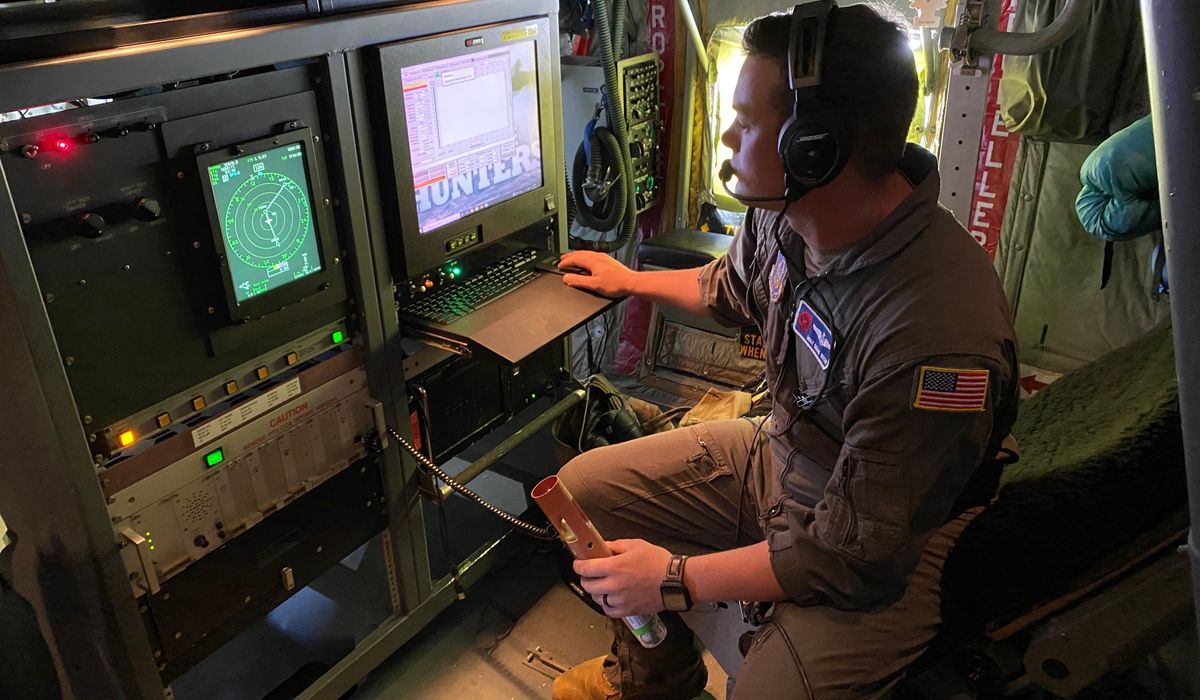


The C-130 aircraft, call sign Teal 53, rolled down the airstrip at Andrews Air Force Base — slowly at first, then quickly picking up speed. As the four Allison turboprop engines screamed, the transport aircraft suddenly lurched off the runway and shot skyward.
The mission that day for Teal 53, part of the “Hurricane Hunters” of the Air Force Reserve’s 53rd Weather Reconnaissance Squadron, was to find some bad weather out over the Atlantic, the kind of bad weather most pilots spend their lives trying to avoid.
Based at Keesler Air Force Base near Biloxi, Miss., the 53rd WRS is responsible for hurricane reconnaissance missions in the Atlantic Ocean, the Caribbean Sea, the Gulf of Mexico, and the eastern and central Pacific Ocean area. Not only are the Hurricane Hunters the only such unit in the Air Force, they’re the only ones in the world doing their particular mission.
The Hurricane Hunters regularly work with the National Oceanic and Atmospheric Administration (NOAA) which does carry out weather analysis assignments. But it is a civilian scientific agency focusing on long-term atmospheric research.
“We’re not doing the same thing when we’re out there,” said Maj. Christopher Dyke, an aerial reconnaissance weather officer (ARWO) with the Hurricane Hunters. “What we’re doing is collecting data going into the model that’s actively running.”
The Hurricane Hunters fly the WC-130J, which carries a crew of five: pilot, co-pilot, navigator, weather officer and an enlisted loadmaster. The ARWO operates the computerized weather reconnaissance station in the front section of the airplane’s cargo compartment and acts as the flight director once the craft reaches the outskirts of the storm.
“That’s where the ‘business’ gets done,” Maj. Dyke said. “Once we’re ‘turned on,’ it’s 24/7 — just constantly churning missions until the storm makes landfall.”
During Atlantic hurricane season, which officially begins on June 1, a crew from the 53rd WRS would be wheels up and heading to their target within 16 hours of being notified. On April 24, it took Teal 53 about 45 minutes to reach the location over the Atlantic where their work that day would begin.
Even with the growth of technology like satellites and Doppler radar which can produce velocity data about objects at a distance, there are still elements of high-risk weather patterns like hurricanes that can’t be adequately measured without physically being at the scene.
“A forecast model is only as good as the data that goes into it,” Maj. Dyke said.
Their mission is to take a vertical profile of the atmosphere at the target location. They use what’s called a “dropsonde,” an expendable weather reconnaissance device, to collect information about the temperature, dew point, air pressure, wind speed and direction. The dropsonde is about the size of a roadway flare and is launched out of the aircraft with a small parachute.
Paying dividends
The dangerous work yields dividends: Mike Brennan, the director of the National Hurricane Center in Miami, said the data collected by the Hurricane Hunters improve their forecasts by at least 20%.
“Our forecasters take that information and use it to issue five-day forecasts of where the storm is going and more importantly, those hazards — the rainfall, the storm surge, the winds — and where those worst conditions could occur,” Mr. Brennan said in a statement. “We provide that information to local meteorological services and then they issue forecasts, watches and warnings for their local populations.”
Master Sgt. Shane Hogue, the loadmaster for Teal 53, launched the dropsonde from his station in the cargo bay and tracked its descent on his computer screen. It collected weather data for about 10 minutes before finally hitting the water.
The WC-130Js flown by the Hurricane Hunters are sturdy workhorses and are built to absorb the buffetting and turbulence from the storms their crews encounter.
“Most of them aren’t that bad, but there are moments when I’m like, ‘Why am I doing this?’” Master Sgt. Hogue said with a laugh over the screaming of the engines.
Like any unit in the military, the Hurricane Hunters are competing for their share of the pie. The C-130s they use are starting to show their age.
“These J models are the oldest ones we have and they’ve been flying in hurricanes,” said Maj. Gen. McCauley Von Hoffman, deputy to the chief of the Air Force Reserve. “They not only have many years of operations but also the conditions. They operate in a highly corrosive environment.”
Air Force leadership has competing priorities they must balance, including those based on great-power military competition with countries like China and Russia, Gen. Von Hoffman said.
“But if you’re the governor of Mississippi, Alabama, Florida, or Louisiana, you really care about the modernization of this platform,” she said. “They’re showing a lot of wear and tear. There’s a point at which sustaining a weapons system becomes … too expensive because nobody wants to make the parts for it.”
Changing weather patterns mean that the missions for the Hurricane Hunters are increasing with each season. The squadron currently has 10 crews each of full-time reservists and part-timers. In addition to tracking storms approaching the U.S. coastline, they are regularly tasked to assist government agencies engaged in atmospheric research.
The National Hurricane Center is now moving to a seven-day forecast model and that means extra work for the crews in the squadron, Maj. Dyke said.
“We’re in our two-month break right now,” he said. “But, we’re going to be flying into the storms earlier in its development. Changes have a ripple effect on our operational tempo.”
• Mike Glenn can be reached at mglenn@washingtontimes.com.
